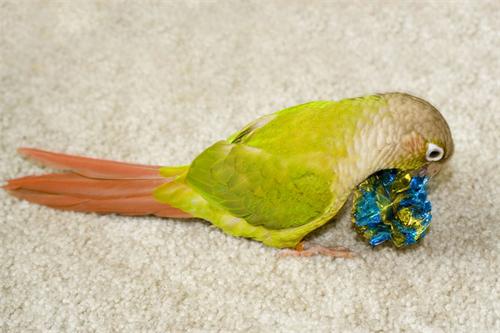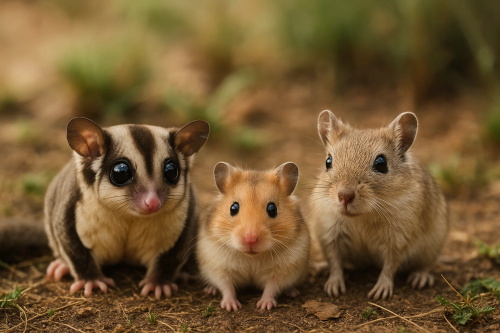Behavioral Enrichment for Birds & Exotic Pets: Parrots, Reptiles, & More

Exotic pets—ranging from brightly colored parrots to fascinating reptiles and small mammals—require more than just proper housing and diet to thrive. In captivity, one of the biggest challenges they face is boredom and stress caused by a lack of stimulation. Behavioral enrichment, a concept originally developed for zoo animals, has now become an essential part of responsible pet care. It helps keep pets’ minds active, promotes natural behaviors, and prevents psychological and physical decline. For birds and exotic pets, this can mean the difference between a dull existence and a vibrant, fulfilling life.
The Importance of Behavioral Enrichment
Behavioral enrichment refers to any activity or modification in an animal’s environment that encourages natural behaviors and mental engagement. In the wild, parrots spend hours foraging for food, reptiles explore and bask in varying microclimates, and small mammals like sugar gliders interact socially or glide from tree to tree. Captivity limits these opportunities, which can lead to boredom, anxiety, aggression, and self-destructive behaviors such as feather plucking or pacing.
Providing enrichment mimics the complexity of their natural environment, stimulating their minds and bodies. Enrichment also strengthens the human-animal bond, as pets learn to interact with their owners through play and exploration.
Enrichment for Parrots: Keeping the Mind in Flight
Parrots are among the most intelligent pets in the animal kingdom, often compared to toddlers in terms of problem-solving skills and emotional sensitivity. Without adequate stimulation, they may become frustrated, noisy, or even self-harming.
Foraging and Feeding Challenges
In nature, parrots spend up to 70% of their day searching for food. In captivity, their meals are often placed in a dish, taking only seconds to consume. To encourage natural behaviors, owners can use foraging toys or puzzles that make birds “work” for their food. Hidden treats in paper cups, wrapped parcels, or food-dispensing balls can turn mealtime into a rewarding activity.

Toys and Rotation
Parrots love to chew, shred, and manipulate objects. Wooden blocks, rope knots, and paper-based toys satisfy their instinct to gnaw and destroy. However, rotating toys every week keeps things fresh and prevents boredom. Each new toy offers a novel sensory experience—whether it’s a new texture, color, or sound.
Social and Vocal Interaction
Many parrots are flock-oriented and require social interaction. Spending time talking, singing, or even training them with positive reinforcement (using treats or praise) provides mental stimulation. Simple games like “peek-a-boo,” call-and-response training, or mimicking can deepen the bond and keep their minds engaged.
Environmental Enrichment
The cage setup also plays a vital role. Varying perch sizes and materials helps maintain foot health. Offering swings, ladders, and climbing branches encourages movement. Safe outdoor aviary time—under supervision or in a secure harness—exposes parrots to sunlight, fresh air, and natural sounds, which boost their physical and emotional well-being.
Enrichment for Reptiles: Engaging the Cold-Blooded Mind
Reptiles, though less expressive than birds, also benefit from enriched environments. Their enrichment focuses more on creating complex and stimulating habitats that replicate their wild surroundings.
Habitat Design and Microclimates
In the wild, reptiles navigate diverse terrains—rocks, logs, burrows, and vegetation—each providing temperature and humidity variations. A well-designed enclosure should include basking spots, shaded retreats, and climbing or hiding areas. Creating gradients of heat and light encourages natural thermoregulation and exploration.
Scent Trails and Novel Objects
Introducing new scents can stimulate a reptile’s curiosity. Owners can use natural herbs, leaves, or reptile-safe scent markers to create scent trails. Placing new rocks, logs, or branches every few weeks adds novelty and encourages investigative behavior.
Feeding Enrichment
Instead of placing food in a dish, try hiding insects under leaf litter or inside a small maze. For snakes, using tongs to mimic prey movement makes feeding time more stimulating. The act of hunting engages both body and mind, promoting healthier feeding responses and preventing obesity.
Observation and Behavior Training
While reptiles may not “play” like parrots, they can learn to associate their owners with positive experiences. Gentle, regular handling (for species that tolerate it) reduces stress. Some reptiles, such as bearded dragons or tortoises, can even be trained to target-feed or follow a visual cue, making feeding time more interactive.
Enrichment for Small Exotic Mammals: Hamsters, Sugar Gliders, and More
Many small exotic pets have complex social structures and high activity levels. For them, enrichment focuses on space, social engagement, and sensory stimulation.
Hamsters, Gerbils, and Rodents
These animals are natural diggers and foragers. Deep substrate layers allow burrowing and nesting, while tunnels and cardboard mazes simulate natural underground environments. Scatter feeding—spreading food across the enclosure—encourages exploration and physical activity. Chew toys made from safe woods or cardboard help maintain dental health and prevent boredom.

Sugar Gliders and Hedgehogs
Sugar gliders are highly social, nocturnal creatures that love to climb and glide. Providing vertical climbing spaces, hammocks, and glider-safe branches encourages exercise. Rotating toys, hiding treats, and offering interactive playtime strengthen their bond with owners.
Hedgehogs, on the other hand, enjoy exploring new scents and textures. Simple objects like crinkled paper balls, tunnels, or scented cloths add enrichment to their environment. Exercise wheels with solid bases are essential for maintaining physical health.
Sensory Enrichment: Stimulating All Senses
All exotic pets benefit from sensory enrichment—stimulating sight, sound, smell, touch, and even taste.
Visual: Vary lighting conditions or move enclosures where pets can safely watch household activity or nature through a window.
Auditory: Soft background music or nature sounds can calm or engage certain species. Birds often enjoy rhythmic or melodic tunes, while reptiles may respond to ambient environmental sounds.
Olfactory: Introducing safe, non-toxic scents or herbs encourages investigation and mental engagement.
Tactile: New textures, surfaces, or climbing materials—such as bark, rope, or cork—keep touch senses active.
Gustatory: Offering a variety of safe foods, textures, and flavors enhances mealtime interest.
The Role of Routine and Variation
Consistency builds trust, but variation keeps pets engaged. Rotating enrichment activities, toys, and setups weekly or biweekly prevents predictability while maintaining structure. Owners should observe their pets’ responses—whether excitement, curiosity, or avoidance—to tailor enrichment strategies that suit individual preferences.
Keeping a journal of enrichment activities can also help track what works best. For example, a parrot might prefer shredding toys over bells, while a lizard might explore more actively after the introduction of new logs.
Social and Cognitive Enrichment
Cognitive enrichment focuses on mental challenges that require problem-solving or learning. Training sessions, puzzles, and interactive feeders fall under this category. For social species, companionship—whether from another animal or the owner—is equally enriching.
Parrots, for instance, can learn to identify colors, shapes, or objects through consistent training. Reptiles, while not traditionally social, can benefit from safe cohabitation setups (species permitting) or exposure to non-threatening visual stimuli.
Environmental Safety and Supervision
While enrichment should be stimulating, it must always be safe. Avoid small parts that could be swallowed, toxic plants, or sharp edges. For reptiles, ensure temperature and humidity remain within species-appropriate ranges. For parrots and small mammals, supervise playtime outside cages to prevent accidents or exposure to household hazards.
Emotional Enrichment and Human Interaction
Exotic pets, especially birds and social mammals, can develop strong emotional attachments to their caretakers. Regular, gentle interaction builds trust and provides emotional enrichment that no toy can replace. Talking, hand-feeding, or allowing them to perch or explore near you can reduce loneliness and anxiety.
The Future of Enrichment for Exotic Pets
The field of pet enrichment continues to evolve, driven by research and innovation. From smart feeding devices that mimic foraging to bioactive terrariums that replicate entire ecosystems, pet owners today have more options than ever to improve their animals’ quality of life. The future may even bring adaptive AI-driven enrichment systems that monitor an animal’s activity and automatically adjust environmental complexity.
Behavioral enrichment isn’t just an optional luxury—it’s a fundamental component of animal welfare. Whether you’re caring for a talkative parrot, a curious gecko, or a playful sugar glider, understanding and addressing their behavioral needs can transform their daily lives. A thoughtfully enriched environment nurtures natural instincts, improves health, and deepens the connection between pet and owner.
By prioritizing enrichment, owners become more than caregivers—they become partners in their pets’ mental and emotional well-being. The goal is not to simply keep exotic pets alive, but to help them truly thrive.



